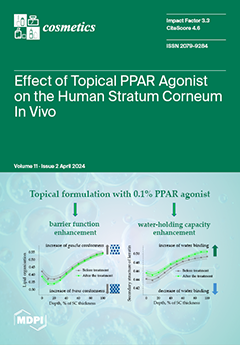There is a considerable increase in the use of substances and medical procedures aimed at changing the esthetics of the face, particularly the appearance of the lips. Permanent fillers such as polydimethylsiloxane, also called liquid silicone, are widely used, but their application for
[...] Read more.
There is a considerable increase in the use of substances and medical procedures aimed at changing the esthetics of the face, particularly the appearance of the lips. Permanent fillers such as polydimethylsiloxane, also called liquid silicone, are widely used, but their application for facial esthetics is currently obsolete. Silicone belongs to this polymer family; its viscosity is determined by its degree of polymerization. Liquid injectable silicone is odorless, colorless, non-volatile, and oily to the touch. The substance is not altered by storage at room temperature and is not carcinogenic or teratogenic. However, the long-term complications remain a reality, as they can occur decades after the application. Thus, the goal of this case report was to present a complication after 16 years of treatment using liquid silicone. This case report involved a 52-year-old male with a complication of bilateral permanent filler in the upper lip performed 16 years ago, its surgical removal, and histological analysis. The patient had the first appointment at the University Dental Clinic—Universidade Católica Portuguesa (Viseu, Portugal) in April 2022, dissatisfied with his upper lip’s esthetic appearance and shape. He was not a smoker or diabetic but had hypertension and hypercholesterolemia and was medicated with Losartan, Hydrochlorothiazide, and Pitavastatin. No relevant findings were observed in the extraoral examination; he had bruxism and a good periodontal condition. The patient had an asymptomatic bilateral mass, hard to palpation, located on the upper lip due to permanent lip filling performed to increase its volume in 2006 associated with non-related generalized granules of Fordyce. The treatment options presented just observation or complete material removal in two surgical steps, which was the patient’s choice. Then, the first surgical procedure was performed under local anesthesia on the right side of the lip, one carpule of Lidocaine 2% with adrenaline 1:100,000, with a chalazion clamp, a diode laser for hemorrhagic control, and a simple suture. In this procedure, three fragments were biopsied: a cuboid measuring 1 × 1 × 0.8 cm and an irregular one consisting of two fragments that at one end of the piece were in continuity with each other, one measuring 1.6 × 0.5 × 0.4 cm and the other 2.5 × 0.6 × 0.5 cm. A similar macroscopic appearance in all the material, white in color, irregular surface, elastic, white section surface, or slightly fasciculate. The patient was medicated with Tylenol 500 mg thrice a day for two days. With 20-day intervals, the sutures from the first surgery were removed, as well as the foreign body from the upper lip on the left side, following the same surgical technique and medication. Histologically, it was possible to identify a chronic inflammatory, lymphoplasmacytic, and granulomatous reaction, with foreign body giant cells’ reaction, in relation to non-polarizable exogenous material due to the reaction to silicone. The most common complications are granulomas’ appearance and material displacement. The case report shows these granulomas are characterized as chronic low-caliber inflammation around the silicone. They have an unknown etiology but are probably multifactorial, from continuous trauma, friction or irritation, iatrogenic factors, infection, immunological mechanisms, and genetic and molecular variations, and can be highly related to the impurity of the injected material. This case brings the opportunity for health professionals to increase awareness of the long-term adverse effects of the silicone material used to fill the lip in order to make its application more predictable and conscious.
Full article





